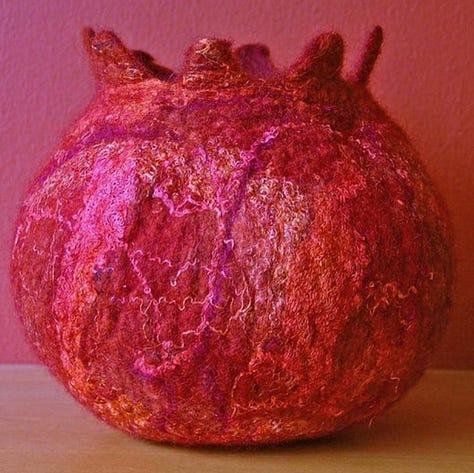ANATOMY: The dream catcher of the pelvis
The skills and creativity of visual and textile artists offer fresh perspectives into our felt-understanding of the tissues of our pelvis.
This is the second set of Field Notes about the pelvis (take a look at the first set here). Attuning to the connective tissues and muscles requires a different level of attention rather like the experience of seeing how an artist creates a painting. On first view you see the image, the composition, the colours, but step closer or increase the light of your attention and you will see the brush strokes and the careful colour combinations of light and shade.
Here are some ideas to support your more detailed somatisation process.
1. LIGAMENTS
It’s often the way that when we have become familiar with our bones, we then reach for an understanding of the muscles. Pause that impulse. Take time to look at a map of the ligaments. Consider how the ligaments secure the relationship of the bones and imagine gathering the bones together along the grain lines of the ligaments. It can add a sense of containment that is very different from muscular contraction.
2. MAPPING THE MUSCLES
Find some anatomical pictures of the muscles of the pelvis or head to my Pinterest Board and you'll find some images of female maps there. As you look at the different views, describe what you see - it doesn't have to be in anatomical terms - you might see shapes, openings, contour lines, a sense of movement; maybe there are images that come to mind.
Register the bony landmarks that are relevant to the muscles: the anchor points of their tendons. If you were to think about the opening of the pelvis as a circle, then using compass points can be a useful way of navigating the anatomy, for example: north/pubic bone, south/coccyx, east and west/the two ischia or sit bones. Connecting the compass points will give you a cross-hair to the perineal body, and a map of four quadrants. You might discover that your muscular tone is not even across the quadrants, particularly if you have perineal scarring.
Finally notice the grain lines of the muscle which will give an insight into the direction of contraction in the fibres. Notice also the openings, and the central tendon. Explore isolating the contractions of each muscle so that you begin to free yourself (and the individual muscles) from the idea of being a “floor” – an image that doesn’t in any way illustrate the dynamics of the structure.



3. A VIEW FROM THE SEWING ROOM
If you were going to sew a lining for the bowl of the pelvis, then you would probably start with a circle of fabric and run a gathering stitch around its circumference. When you pulled on this thread the fabric would transform from a flat structure to a soft container,
Now, if you had to patchwork a circular piece of a fabric from different shaped pieces, then it might make sense to organise the pieces around a centre – this would provide a common point of security for each piece. Take another look at your muscle map and note how the muscles are anchored by the central tendon, or perineal body.
Experiment with gathering the sense of your muscular container towards the perineal body, as well as gathering around the circumference – it’s likely that some areas feel less responsive to your intention.
4. DREAM CATCHERS
In the first set of Field Notes, I suggested imagining a small bead in the centre of your pelvis bowl suspended by threads in all directions, or as the circle at the centre of a dream catcher, to explore the evenness of tone in the pelvic tissues. We can use another dream catcher design to explore the tissue dynamics of the pelvic openings and their associated musculature, namely (for female maps) the urethral opening, the vagina, and the anus. These three openings are suspended in the fibres (threads) of your muscles and you may experience differences in tone around each of them.
Explore creating a felt-sense of lifting or - here’s that word again – gathering each opening upward, converging towards a central point in the upper circumference of your pelvic bowl. If this helps, it might be where you sense the location of your sacral cakra – in fact, if you wanted to explore separately the sense of sahajoli mudra, mūla bandha, and ashwini mudra you probably end up in the same place in terms of a felt-experience in the tissues.



5. A QUESTION OF BREATHING
In the muscular action of breathing we know that the movement of the thoracic diaphragm causes a downward pressure on the organs and that this is ‘caught’ by the pelvic diaphragm. It is commonly held that the pelvic diaphragm therefore descends on the inhalation and returns upward on the exhalation. I would like to suggest exploring this as a hypothesis and being open to something else happening - it helps to imagine that the pelvic bowl is empty.
Settle into conscious breathing and notice as the bony landmarks move away from each other on inhalation, the tension across the lining increases and the bowl becomes more shallow i.e. the ‘floor’ of the bowl rises. On exhalation the tension releases and the bowl deepens, i.e. the ‘floor’ for the bowl descends. If this is the case, then yes, there is a downward movement through the weight of the organs however could it be that it is caught by the rise of the pelvic diaphragm. What do you think? What’s your experience?
Check our how the amazing Bonnnie Bainbridge-Cohen explains things here.
Did you find this interesting? Useful? Want to explore further? Then please consider a paid subscription for a DEEP DIVE into my FIELD NOTES for extended movement enquiries, access to image collections, playlists, and journaling prompts.
I’m hugely grateful for each investment in supporting my time, thought and work. And, please do share this post to friends and colleagues. THANK YOU.





